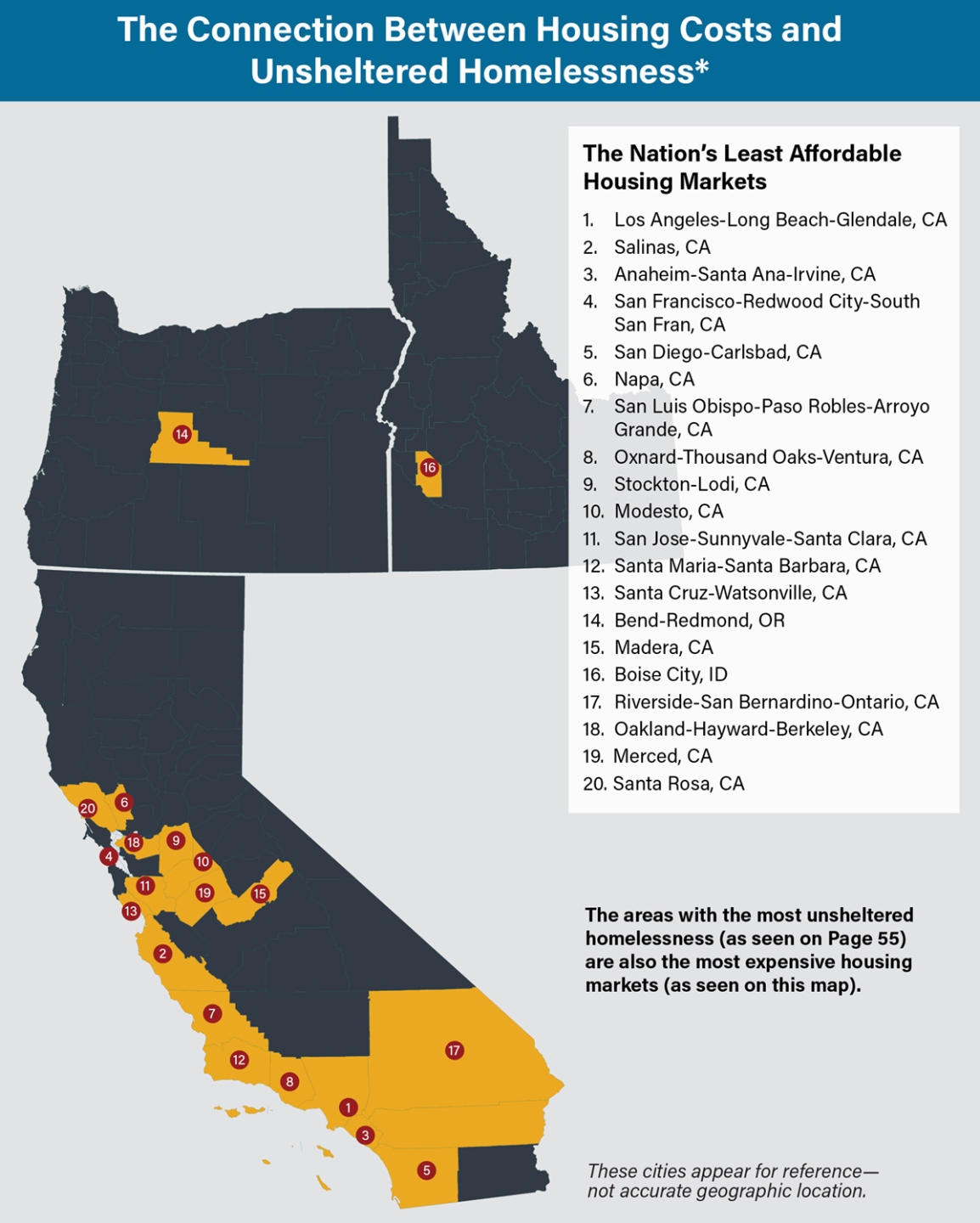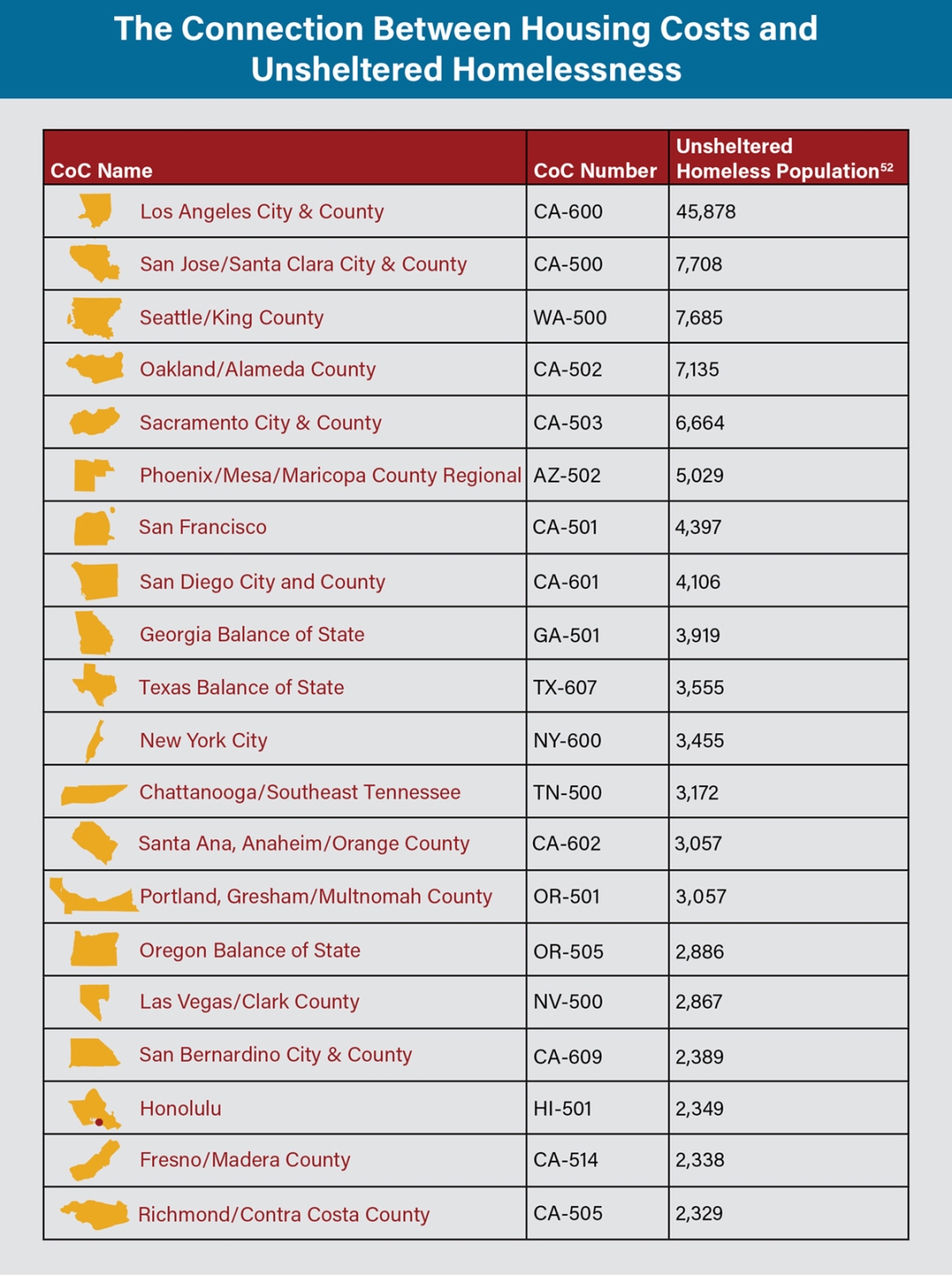All In serves as a roadmap for federal action to ensure state and local communities have sufficient resources and guidance to build the effective, lasting systems required to end homelessness. While it is a federal plan, local communities can use it to collaboratively develop local and systems-level plans for preventing and ending homelessness. This plan creates an initial framework for meeting the ambitious goal of reducing overall homelessness by 25% by 2025 and sets the United States on a path to end homelessness.
This plan is built around six pillars: three foundations—equity, evidence, and collaboration—and three solutions—housing and supports, homelessness response, and prevention—all of which are required to prevent and end homelessness. Within each pillar of foundations and solutions are strategies that the federal government will pursue to facilitate increased access to housing, economic security, health, and stability. Some agency commitments, cross-government initiatives, and efforts are already underway and are highlighted throughout.
Upon release of this plan, USICH will immediately begin to develop implementation plans that will identify specific actions, milestones, and metrics for operationalizing the strategies in close partnership with its member agencies and other stakeholders representing a broad range of groups and perspectives, including people with lived experience. For more on this, please view the Framework for Implementation.
A community’s response to homelessness must be urgent and focused. The homelessness response system is typically coordinated by the local or regional CoCs. An effective homeless response system should include outreach to unsheltered people, coordinated entry, targeted homelessness prevention and diversion, emergency shelter, permanent housing including rapid rehousing, and wraparound services during and after homelessness.
Strategy 1: Spearhead an all-of-government effort to end unsheltered homelessness.
Unsheltered homelessness—and laws that criminalize it—have been rising, especially in places where the cost of housing has rapidly increased. In 2020, 4 in 10 people experiencing homelessness on a given night were in unsheltered locations, and more than half of the unsheltered population lives in the nation’s 50 largest cities. This unprecedented rise in unsheltered homelessness—including visible encampments—is a direct result of a lack of accessible and low-barrier shelter options, insufficient supply of affordable housing, and voluntary service and support options. Deploying effective programs to meet their diverse needs takes unwavering commitment and unyielding creativity.
To accomplish this strategy, USICH and relevant member agencies will:
- Review requirements for federal programs that fund or support access to basic sanitation supplies and resources, health care services (including services for mental health conditions and/or substance use disorders), and other supports and resources that specifically impact areas where unsheltered people reside to identify barriers to program implementation.
- USICH member agencies that own federal land will promote strong collaboration with local organizations in response to encampments that form on federal property.
- Deploy targeted funding and technical assistance that fosters collaboration between entities that include outreach, housing navigation, aging and disability network organizations, public health, emergency response, law enforcement, health centers and hospitals, and mental health crisis intervention teams.
- Provide guidance and technical assistance on promising and best practices related to encampments, effective street outreach, and harm reduction approaches.
- Spotlight program flexibilities that allow states to take immediate action during emergencies and allow for post-emergency federal approval (with justification) for non-statutory-related requirements, especially housing costs.
- Promote alternatives to criminalization and provide incentives to state, local, and territorial governments to adopt such alternatives.
- Identify strategies for housing-focused outreach that connect people to accessible permanent housing, including rapid rehousing; permanent supportive housing; and affordable and market rent housing, when appropriate.
- Incentivize, strengthen, and expand opportunities for people with lived experience to serve as outreach workers and service providers through programs like Peer Recovery Support, Community Health Workers, and Medicaid HCBS.


Strategy 2: Evaluate coordinated entry and provide tools and guidance on effective assessment processes that center equity, remove barriers, streamline access, and divert people from homelessness.
One key purpose of coordinated entry is to create more fair and standardized processes for access, assessment, and referral. But upon implementation, an overreliance on scores generated by assessment tools and a reliance on “matching” households to a specific resource has often resulted in long waiting lists, rationing of assistance, and exacerbated disparities.
To accomplish this strategy, USICH and relevant member agencies will:
- Collaborate with people with lived experience as well as a range of service providers inside and outside the homeless response system.
- Review and revise federal policies and programs related to coordinated entry to identify inherent challenges that create barriers.
- Commission a multi-community study to evaluate coordinated-entry implementation and recommend federal policy changes to remove barriers and improve process effectiveness.
- Create a new overarching framework for effective coordinated entry using a targeted universalism approach that is inclusive of all key populations, access points, programs, and systems serving people experiencing homelessness and which allows for local flexibility and tailoring based on the needs and resources within the specific community.
- Highlight communities adopting a spectrum of assessment activities that center equity in prioritization, trauma-informed data collection, and offer solutions that tailor assistance based on what clients need.
- Provide guidance, tools, and TA in partnership with people with lived experience and service providers on coordinated-entry system design, assessment processes, and performance measurement that is inclusive of addressing specific needs and goals of different key populations.
- Identify ways to test different approaches to assessment and prioritization—including the use of health and other administrative data—and share outcomes and lessons learned.
Strategy 3: Increase availability of and access to emergency shelter—especially non-congregate shelter—and other temporary accommodations.
Emergency shelter—both congregate and non-congregate—serves a temporary and life-saving role for people in crisis and should be implemented with as few barriers as possible. The key components to effective emergency shelter include culturally appropriate, gender-affirming, and specific, low-barrier access and housing-focused services aimed at rapid exits back to permanent housing.
To accomplish this strategy, USICH and relevant member agencies will:
- Fully implement the Equal Access Rule to reduce barriers for LGBTQI+ people.
- Increase the availability of and access to medical respite care to meet the needs of people who need recuperative care after hospital discharge.
- Increase the availability of and access to low-barrier, and culturally appropriate shelter, especially non-congregate shelter.
- Provide guidance, technical assistance, and training related to the Americans with Disabilities Act and all applicable federal fair housing laws to ensure compliance and that shelters meet the disability-related needs of people with disabilities, including those with mobility-based disabilities.
- In alignment with the 2022 National Drug Control Strategy, promote the integration of high-impact harm reduction interventions within emergency shelter.
- Provide guidance on emergency shelter that defines the role of emergency accommodations, the connection to the larger system, the need to incorporate non-congregate shelter options, bridge housing, and strategies for downsizing shelter over time.
- Provide guidance, technical assistance, and training for emergency shelter operators, including faith-based; family-focused; youth-focused; and domestic violence shelters on (1) evaluating and updating shelter rules, structure, and operations to a low-barrier model that is more accessible and supportive of the needs of people and (2) providing housing-focused services and integrating health care and supportive services into the provision of non-congregate shelter. For families with children, this should also include resources to address the health and developmental needs of children and to improve the environmental conditions while children are living at a shelter.
Strategy 4: Solidify the relationship between CoCs, public health agencies, and emergency management agencies to improve coordination when future public health emergencies and natural disasters arise.
The pandemic and the increase in natural disasters have demonstrated that most communities do not have adequate resources to address the needs of people experiencing homelessness during disasters. Given the multi-faceted needs of people, homelessness response systems should empower all partners—housing and non-housing—to screen, assess, and make referrals to housing systems that can quickly act and provide follow-up support.
To accomplish this strategy, USICH and relevant member agencies will:
- Encourage CoCs, especially in rural and tribal areas, to have an inclusive community crisis response plan in the event of an emergency or a local surge in the need for shelter and/or housing placements.
- Enhance and expand technical assistance and training on disaster response and recovery planning for homelessness systems with special attention to the disparate impact to already unhoused people.
- Facilitate greater collaboration between federal partners that play a key role on disaster and public health response—including HUD, HHS, and DHS—and national emergency management associations and trade groups—including the National Emergency Management Association, International Association of Emergency Managers, and Association of Healthcare Emergency Preparedness Professionals.
- Continue to encourage state emergency management agencies to include people experiencing homelessness in their disaster response and emergency management protocols with attention to particularly vulnerable populations such as older adults and people with disabilities who are experiencing homelessness. Share resources with cities and counties on how to create multi-system coalitions that partner with local public health agencies to drive down homelessness and reduce barriers to permanent supportive housing.
- Increase collaboration with the Environmental Protection Agency to focus on better understanding how climate change will exacerbate the condition of homelessness.
Strategy 5: Expand the use of “housing problem-solving” approaches for diversion and rapid exit.
Housing problem-solving (HPS) is a set of techniques that support the effective implementation of diversion and rapid exit strategies and should be integrated into all homelessness response and coordinated entry systems. HPS is a person-centered approach that seeks to identify flexible and cost-effective alternative housing solutions that can be implemented quickly. HPS is typically initiated through an exploratory conversation that can occur during street outreach, emergency shelter intake, or coordinated-entry access. HPS can increase equity, reduce trauma, and support community efforts to end homelessness while ensuring housing assistance is prioritized for the people with the highest needs.
To accomplish this strategy, USICH and relevant member agencies will:
- Identify federal programs that can be used and adapted to support community efforts to integrate housing-problem solving into homelessness response systems, ensuring accessibility to all populations.
- Encourage partners—such as law enforcement, early childhood settings and schools, employment training centers, and hospitals—to adopt housing problem-solving that is inclusive in its approach.
- Provide guidance, training, and technical assistance on housing problem-solving, providing accommodations, and associated practices, such as motivational interviewing and mediation to homeless services providers as well as other community partners such as law enforcement, schools, employment training centers, and hospitals.
Strategy 6: Remove and reduce programmatic, regulatory, and other barriers that systematically delay or deny access to housing for households with the highest needs.
Complicated eligibility and documentation requirements can significantly delay the process of getting someone off the streets and into housing. The federal government should ensure that programs “fit” people experiencing homelessness and do not require people experiencing homelessness to “fit” into programs.
To accomplish this strategy, USICH and relevant member agencies will:
- Examine ways to ease eligibility and documentation requirements for specific subpopulations, such as people who are chronically homeless.
- Consider strategies that would streamline eligibility and access processes such as “categorical eligibility”, which would allow people to qualify for multiple programs at once without duplicative processes and “conditional eligibility,” which would allow immediate entry into housing with a grace period for required documentation.
- Provide more training and guidance on fidelity to Housing First and promote examples of successful implementation.
- Review all programs targeted to people at risk of or experiencing homelessness and remove barriers to implementing Housing First approaches with fidelity.



